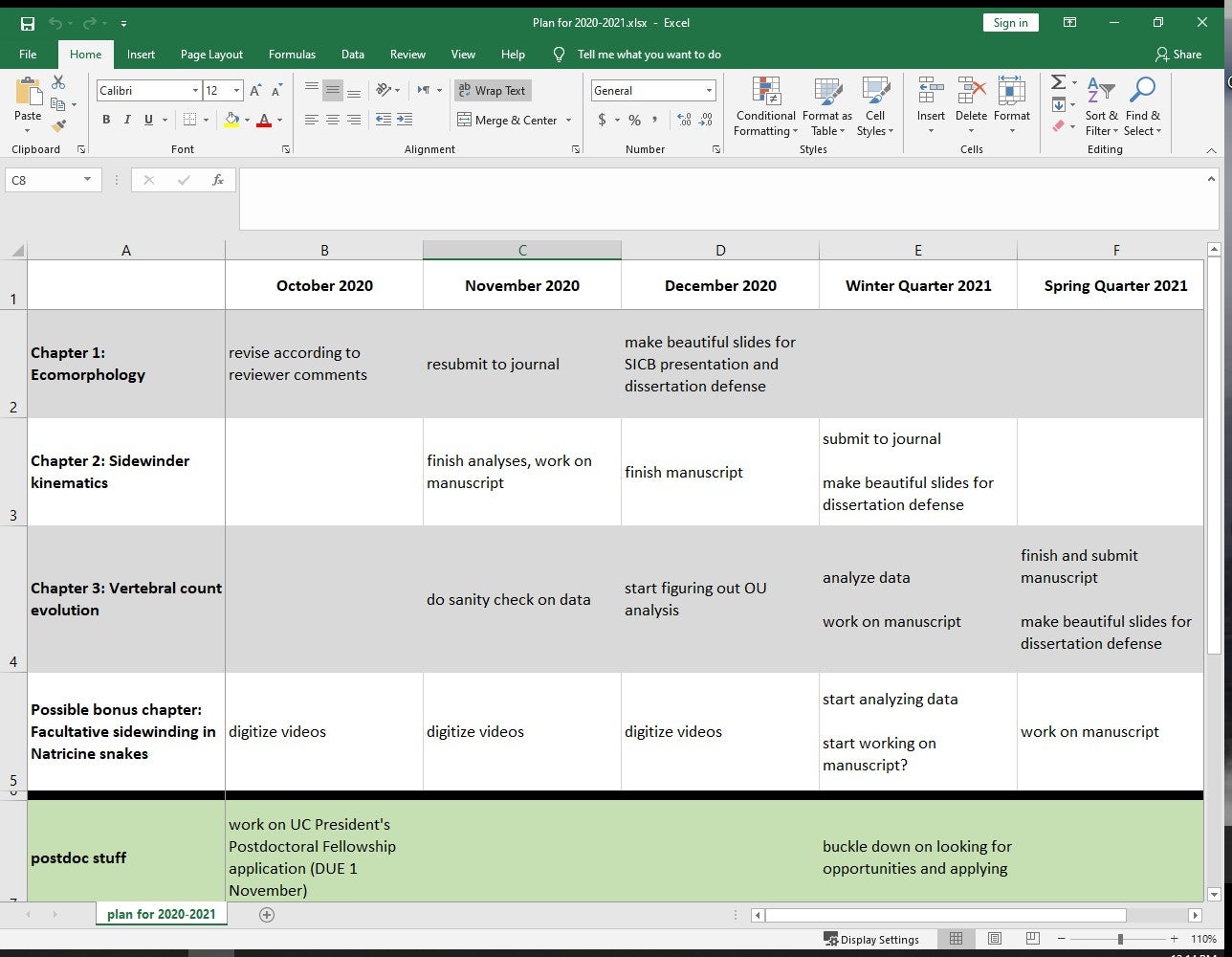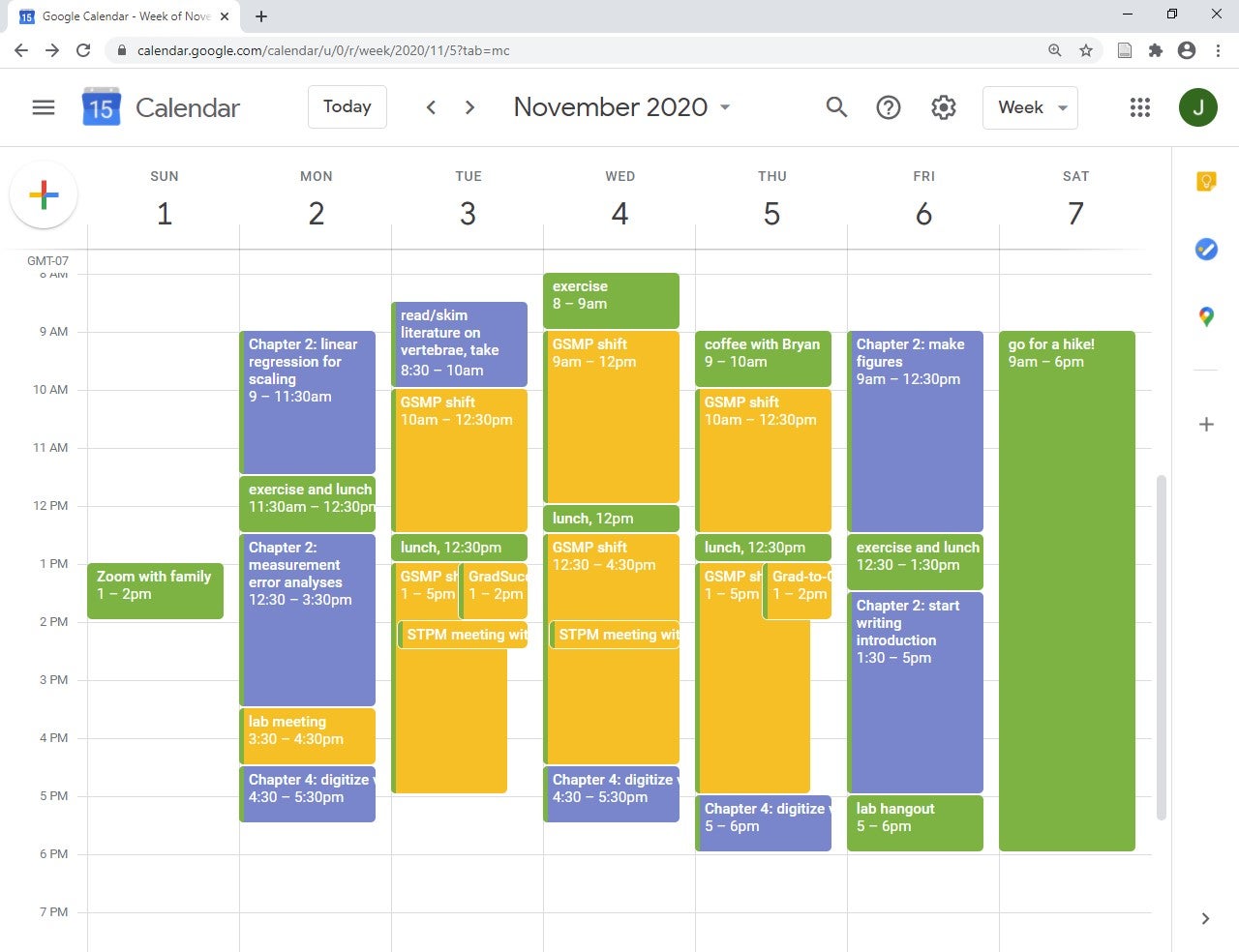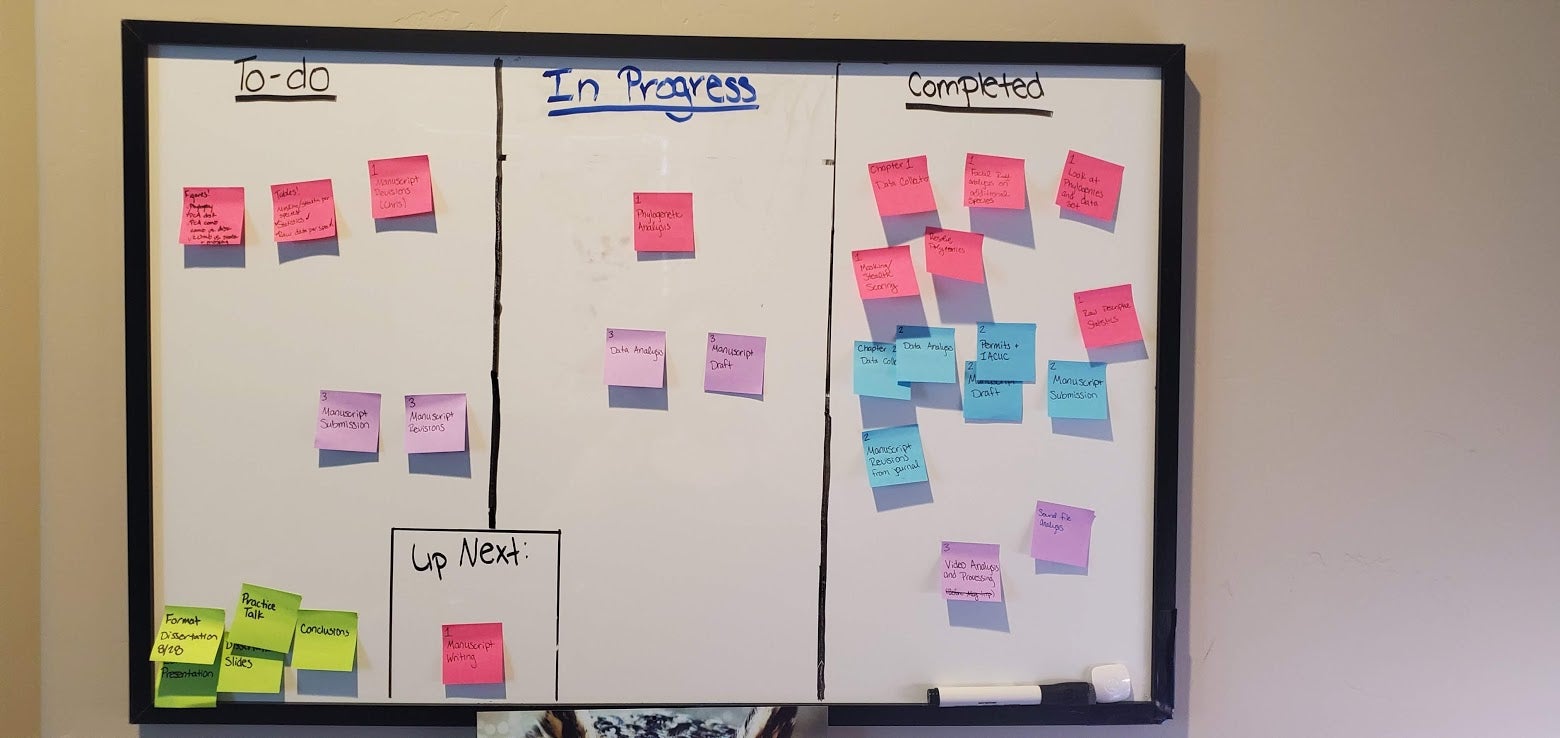Supporting Graduate Students' Academic and Professional Success

Grad school can give you freedom you didn’t have in undergrad: freedom to pick up new skills on your own timeline, freedom to explore your interests more deeply, freedom to design and carry out your own research. Faculty advisors and mentors provide varying degrees of oversight, but in general, it’s up to you to set your goals and do what it takes to reach them. Here are some tips to help you keep yourself on track.
Setting goals
Before setting yearly and quarterly goals, it helps to think about your ultimate career plan. It’s okay if you aren’t sure what career path you might take, but you will help your future self out by considering the possibilities and finding out what each one will require of you. You can re-evaluate each year and adjust your plan as your ultimate career interests change, but you definitely want to get started sooner rather than later.
Are you hoping to end up in a tenure track job at a research-focused university? A primarily undergraduate institution? A community college? Might you want to leave academia to pursue work in industry, a non-profit organization, or a government entity? Do you want to start your own business or organization? Do you still need to visit the Career Center or talk to more senior folks in your field to find out what career options are even available to you?
Hiring committees will look for different accomplishments depending on the type of job you apply for. You will be most competitive if you keep this fact in mind from the start of grad school. This way you can make sure you obtain the necessary experience year-by-year. A non-exhaustive list of skills, experiences, and outcomes/products to cultivate might include:
- Publications
- Experience with specific research techniques
- Teaching experience (perhaps in multiple course types or modes of instruction)
- Management or administrative experience
- Policy experience
- Ability to code in one or more languages, or proficiency with some kind of specialized software
- Competence in statistics or data science
- Written and oral communication skills, perhaps in specific modes of communication or specific media
- Connections with influential people in particular sectors
- A portfolio of some kind
In addition to professional goals, you might have personal goals for your time in grad school. Do you want to learn a new language? Pick up a new instrument? Perfect your master chef skills? Start a family? You may find it easier to make time for your personal goals if you consider them along with professional goals as you make your grad school plans.
Creating a long-term plan
Before making a specific plan, you may find it helpful to map out a very general three-year or five-year plan. You’ll want to revisit it regularly (2-4 times a year) to check your progress and update the plan as needed. A first-year grad student’s plan might look something like this:
|
Year |
Learning/Program Goals |
Research Goals |
Professional Goals |
|
1 |
required classes + statistics or language course |
literature review, brainstorm potential dissertation chapters |
attend a conference |
|
2 |
written qualifying exam |
begin data collection; apply to grants and fellowships |
present at a conference |
|
3 |
oral qualifying exam; Diversity Certificate Program |
start writing up first manuscript; continue working on other projects |
present at a conference; summer policy internship |
|
4 |
University Teaching Certificate Program |
submit first manuscript to a journal; continue working on other projects; apply to UCR Dissertation Year Fellowship |
present at a conference; start looking into jobs/postdocs |
|
5 |
defend dissertation |
finish up second and third projects; write dissertation; submit second manuscript to a journal |
apply to jobs/postdocs |
[Image Description: You might break up your long-term plan into different categories, such as learning goals and/or program requirements, research goals, and professional goals. Think about which categories would make the most sense for you.]
To make a more specific plan for the current year, you can start by listing the time-sensitive tasks you need to complete, organized by quarter. You’ll want to include things like:
- Required coursework
- Program requirements to be completed this year, like written and oral qualifying exams or annual reports
- Conferences you plan to attend (including abstract submission deadlines, if you plan to present)
- Grants and fellowships relevant to you, with their due dates
- Any planned trips (to collect data, for example)
Then you can make a list of things you hope to accomplish that don’t have a deadline. Chunk things into manageable pieces – instead of putting a large, vaguely defined item like “work on Chapter X” on your list, try breaking it up into smaller, more concrete tasks:
- “Collect data for Chapter X”
- “Analyze data for Chapter X”
- “Write methods section for Chapter X”
- “Write introduction for Chapter X”
- “Make pretty figures to use in Chapter X manuscript and presentations”
Note: you wouldn’t do all of these things in a single quarter! That’s why it helps to break dissertation-related tasks up into chunks. In addition to things you need to accomplish for your dissertation, you might also want to add other personal and professional goals, like taking an online course to learn a new skill.
Now that you have a list of tasks to accomplish during the academic year, you can map them out quarter by quarter.
How you make a quarter-by-quarter map will depend on your own personal preferences, but it’s always a good idea to try out different ways of doing things before settling on one. You might write down your plan in a notebook, or on a piece of paper that you can tape to the wall above your desk. You might go digital, making a Word document, a spreadsheet, or a personal wiki site so that you can easily update the information as plans change. You might decide to use several of these options, or a different system entirely.
[Image Description: This example spreadsheet shows a plan for the three quarters of the current academic year]
Staying on track day-to-day and week-to-week
To keep yourself on track in the short term, it’s helpful to break tasks up into the smallest chunks possible. It’s also helpful to think of tasks in terms of the mental effort they require.
Lower mental effort tasks:
- any tedious or monotonous research-related task (will vary by field)
- organizing your workspace
- making a list of things you’d like to do next week
- making a list of grants you could apply to some day
Moderate mental effort tasks:
- reading articles and taking notes
- making a simple, standard figure for a paper or presentation
- working on your CV
- grading homework assignments
Higher mental effort tasks:
- figuring out a new type of analysis
- making an unusual or complex figure for a paper or presentation
- writing an introduction section for a paper
- writing a teaching statement
A low mental effort task for one person might be a high mental task for another, and that’s okay!
Considering the mental cost of each task will help you organize your time optimally. For example, if you tend to work best first thing in the morning, plan to generally knock out higher mental effort tasks early in the day. If you know that you need to warm up first, start with lower-to-moderate mental effort tasks, and then move on to the more challenging ones. In general, it’s a good idea to tackle the most difficult thing that you are up to at any given time. Some days, you may not have the energy to tackle those higher-effort tasks. On those days, you’ll be thankful to have a list of easy things to do while you wait for your energy reserves to fill back up.
Several methods can help you stay on top of a daily or weekly to-do list. You might keep a good old-fashioned list in digital or paper format, crossing things off as you go. You might use Google Calendar as your to-do list. You might learn about the Kanban method and implement it using post-it notes or a website like Trello. Play around and find a method that makes you feel good about getting your to-do list done!
[Image Description: Calendar apps can help you organize your time to help you accomplish your daily or weekly to-do list]
[Image Description: Moving post-it notes from “to-do” to “in progress” to “complete” on a physical Kanban board can provide a satisfying sense of accomplishment, boosting one’s motivation.]
Being kind to ourselves
“Everything takes longer than you expect it to.” - My advisor’s favorite saying (well, one of them)
Making long- and short- term plans can help us get through grad school, but for some, not sticking exactly with those plans can cause anxiety. Much of that anxiety comes from our own excessive internal expectations of ourselves, and sometimes we need to step back and treat ourselves with more kindness. Although planning and self-discipline can help us make it through grad school, it’s equally important to set aside time to recharge. Sometimes a thing we wanted to accomplish today will have to wait until next week, or a goal for this quarter will have to wait until next year. Or our priorities might change entirely. It’s normal and healthy to adapt our plans as we go.


